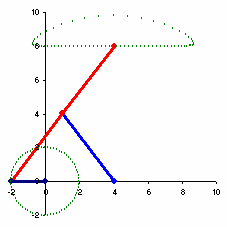Newton’s second law of motion
Let us go back to the legend of Newton and the apple. From the work on statics we will find that the apple stays on the tree as long as the apple stalk is strong enough to support the weight of the apple. As the apple grows there will come a point when the weight is too great and so the stalk will break and the apple falls. The quantity that is being added to the apple as it grows is mass. Sometimes this is confused with weight but there have now been many examples of fruits and seeds being grown inside orbiting spacecraft where every object is weightless and would float if not anchored down.
Mass is the amount of matter in a body, measured in kilograms (kg).
The reason that the apple hangs downwards on the tree, and eventually falls downwards, is that there is a force of attraction between the earth and any object that is close to it. This is the gravitational force and is directed towards the centre of the earth. We experience this as a vertical, downward force. The apple is therefore pulled downwards by the effect of gravity, commonly known as its weight. Any apple that started to grow upwards on its stalk would quickly bend the stalk over and hang down due to this gravitational effect. As the mass of the apple increases due to growth, so does the weight until the point is reached where the weight is just greater than the largest force that can be tolerated by the stalk. As a result the stalk breaks.
Now let us look at the motion of the apple once it has parted company with the tree. It still has mass, of course, as this is a fundamental property to do with its size and the amount of matter it contains. Therefore it must also have a weight, since this is the force due to gravity acting on the apple’s mass. Hence there is a downwards force on the apple which makes it start to move downwards and get faster and faster. In other words, it accelerates. What Newton showed was that the force and mass for any body were linked to this acceleration for any kind of motion, not just falling under gravity. What Newton stated as his Second Law of Motion may be written as follows.
A body’s acceleration a is proportional to the resultant force F on the body and inversely proportional to the mass m of the body.
This seems quite complicated in words but is very simple mathematically in the form that we shall use.
F = ma
Mass is the amount of matter in a body, measured in kilograms (kg).
The reason that the apple hangs downwards on the tree, and eventually falls downwards, is that there is a force of attraction between the earth and any object that is close to it. This is the gravitational force and is directed towards the centre of the earth. We experience this as a vertical, downward force. The apple is therefore pulled downwards by the effect of gravity, commonly known as its weight. Any apple that started to grow upwards on its stalk would quickly bend the stalk over and hang down due to this gravitational effect. As the mass of the apple increases due to growth, so does the weight until the point is reached where the weight is just greater than the largest force that can be tolerated by the stalk. As a result the stalk breaks.
Now let us look at the motion of the apple once it has parted company with the tree. It still has mass, of course, as this is a fundamental property to do with its size and the amount of matter it contains. Therefore it must also have a weight, since this is the force due to gravity acting on the apple’s mass. Hence there is a downwards force on the apple which makes it start to move downwards and get faster and faster. In other words, it accelerates. What Newton showed was that the force and mass for any body were linked to this acceleration for any kind of motion, not just falling under gravity. What Newton stated as his Second Law of Motion may be written as follows.
A body’s acceleration a is proportional to the resultant force F on the body and inversely proportional to the mass m of the body.
This seems quite complicated in words but is very simple mathematically in the form that we shall use.
F = ma




Comments